How to pronounce wine words: http://www.palmbaywines.com/wine_tips_pronunciation.asp
/ˈabsəˌl(y)o͞otlē/ /ˈyo͞osfəl/

How to pronounce wine words: http://www.palmbaywines.com/wine_tips_pronunciation.asp
/ˈabsəˌl(y)o͞otlē/ /ˈyo͞osfəl/
Kings County distillery is New York City’s oldest operating distillery, first since the prohibition. In 2012, the distillery has moved to the Paymaster building in Brooklyn Navy Yard.
They use locally-sources grains, water and barrels for their production. They support local agriculture practices and they even have a small corn field outside of the distillery.
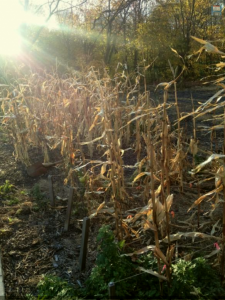
The distillery believes in a locally-sourced agricultural system and some of their corns come from a small corn field outside of the distillery.
After preparing the ingredients such as water, yeast and grains, fermentation starts in wood barrels. The goal of the fermentation is to release as many congeners as possible.
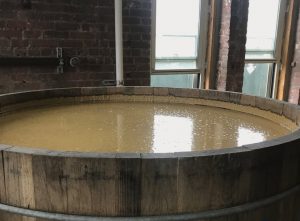
The yeast feeds on sugar sources to create alcohol, carbon dioxide and heat. Fermentation process can take days and even weeks depending on the goal.
After fermentation, distillation process occurs. Distillation of whisky, scotch and bourbon is done mainly on the copper pot stills. Continuous still systems are used for making neutral spirits such as gin and vodka which use both systems.
Still is a container in which the alcohol is separated from the water by heating the liquid to 176 to 212 degrees Fahrenheit. 176 degrees Fahrenheit is the boiling point of alcohol and 212 degrees Fahrenheit is the boiling point of water. After reaching the boiling point of alcohol, it goes into gas form and then condensed back into its liquid form and put in a wooden barrel to start the aging process.
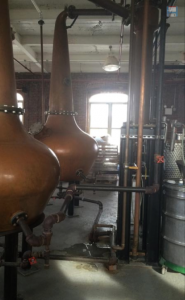
Pot still systems are often very large in size. This allows for greater congener retention compared to continuous stills. The size and shape of the pot influences the overall quality of the end product.
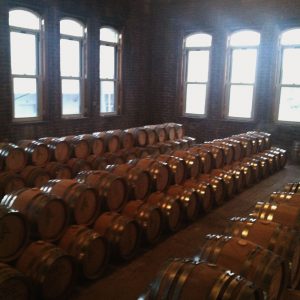
After the distillation process, stills are stored in oak barrels in a designated room. The room has a heavy whisky/bourbon smell with a hint of wood.
Overall, it was a great learning experience. Most of the information provided by the staff was just a repeat of what we have learned in our class. The information I didn’t know prior to my visit was mostly about the history of this particular distillery.
It’s a great starting point for people who are looking to get educated about how their operation works gain new perspectives.
We spend a lot of time talking about frost, I thought this article could make the issue more real: http://www.winespectator.com/webfeature/show/id/Frost-Strikes-France’s-Burgundy-and-Loire-Wine-Regions
It is from seasons past but it made a significant impact in the regions affected and is still being discussed among wine professionals.
In preparation of the lecture on beer please read and view the following:
Who makes Brooklyn Brewery Beer? Learn about Garrett Oliver
How Beer is made:
Click here for another video (this is a concise video)
https://www.youtube.com/watch?v=FttkHVBu2IA
Some history and the current state of Brooklyn Brewery, press here.
There is a difference: Ales and Lagers
There are various types of beer: types of beer
For and in-class activity: press here and pick two beer styles. Reply to this post with the beer style you are going to share with the class.
The region of Burgundy is rich in history and in wine that this is a much watch video.
A few weeks ago I visited the Brooklyn Brewery. It was a Sunday afternoon and I was on the first tour of the day. Upon entering the brewery, the security guys gave my boyfriend and I free tour tickets and told us that we can go have a drink while we wait. We purchase these cute little Brooklyn Brewery tokens that we then exchanged for some beer.
The guys who were serving the beers in the tasting room were very knowledgeable due to the fact that they help making the beer on days that the tours are not in session. They told me that they get their hops and barley mainly from Washington and Oregon, depending on where its best at season. They also asked my boyfriend and I what beers we typically drink so that they can recommend the best tasting beer for us which was very helpful. I tried the Brooklyn Lager and my boyfriend had the Winter Lager. Something that caught my eye was that their cups were made from plants (it said so on the cup) which made them environmentally friendly.
They also had a food cart inside that apparently they change out every week to allow people to try new types of foods while visiting the tasting room. When our tour started, we were allowed to take our beers with us to enjoy while the tour guide told us about their process of making beer. The tour guide started off by asking if anyone knew what the four main ingredients of beer were and I was given a free beer token for answering the question. The four main ingredients are malt/barley, water, yeast and hops. A fun fact that she mention was that hops are a 1st cousin of the marijuana plant. The barley is guided up and mixed in with hot water, it soaks together and creates what is called a mash. That mash is then sent to a lauter tun in which the mash separates into hot and sweet liquid and the grain. That hot sweet liquid is called the wort which is unfermented beer. The wort is then sent to the brew kettle, after the liquid boils, the hops are added for flavor, aroma and also for the beer to preserve better. When that process is over, the liquid is sent to the fermentation tanks and fermented in different ways depending on what type of beer they want to make; a lager or an ale.
After the beer is made it is then either legged or bottled. However all their canned beer and Lager is made in upstate, Utica, NY because those are 60% of their sales and the brewery doesn’t have the space capacity or equipment in the brewery itself to make that much beer. The brewery in Brooklyn actually makes about 1/3 of their beer like their seasonal and special flavors and the factory in upstate makes the other 2/3.
A fun fact is that when Brooklyn Brewery first started off it didn’t even have a name and it was just beer being made out of a house by Steve Hindy. Steve then partnered up with Tom Potter and they decided to make a brewing company. When they were coming up with a logo they wanted so many different things on it but didn’t have any money. They asked Milton Glaser, the creator of the I<3NY logo. It took them a while to even get an appointment with him, but after hassling his assistant for weeks she finally gave them and appointment to see him. He offered them a very simple design (the design that we know now) and asked for a percentage of the company in return and as well as free beer for the rest of his life. He still gets free beer to this day. That is how Brooklyn Brewery began as a company.
I am often asked “What is your favorite wine?”. I can’t answer that question. There is a lot to consider, food, season, mood, cost…and on and on. Beer, however, I do have one favorite it is IPA. I like the bitterness and feel it does with most foods, it transcends season and mood and cost, well, that fluctuates but, oh well, sometimes I will spend the extra dollar.
Throughout the semester we’ve been learning about wines in different regions and how they are made. Finally it was my opportunity to visit a vineyard/winery and actually see what we’ve been discussing in class. One thing that made my visit to Harmony Vineyards which is located at 169 Harbor Rd, St James, NY in Long Island, different was that I went during the evening. It wasn’t intentional but it was a unique way to explore the vineyard and tasting.
Harmony vineyards has been around for 326 years, and has a 4-acre vineyard, and a 32.5-acre waterfront. The grapes variety grown are red: merlot, cabernet sauvignon, and cabernet franc which are blended together to make a Bordeaux-style wine. The white grape variety is just chardonnay to make a Chablis-style wine. Since the vines are in such close proximity to the water they experienced diurnal temperatures which helps moderate the temperature. When we visited harvest had already passed so their was no grapes on the vine and since it was so dark we could see the water and was a bit scared to go too deep into the the vineyard. I was told the Harmony vines doesn’t give tours so my evaluation of the vineyards were concluded from my own knowledge because “I study wine”.
After exploring the vineyards we went indoors to the tasting room to try the wines and ask questions. When asked if I could see their production facility I was told that they don’t make their wines on site, and they send them to LENZ winery, who makes their wines. This really surprised me but at the same time it made sense because the property isn’t really that big. The next day I called LENZ winery which is located upstate NY to get information about the vinification(how the wine is made) practices for Harmony vineyards. I was able to speak with Thomas who’s the assistant winemaker, and he provided me with this information.
For Chardonnay once picked grapes have little contact with skin and goes through bladder press for two hours. The grapes are tumbled and press then moved to a cold temperature steel barrel for two weeks to settle juice. Next it’s moved to another steel barrel kept at 65 degrees for 7 to 8 month. After the wine is filtered to clean sentiments and clarify, then bottled as a still wine. For the red grape variety all grapes are fermented together with skin and left in steel barrels for 2 weeks. Yeast is then added to convert sugar into alcohol, then goes through a press to separate grape from juice after fermentation. Next the wine sits in oak barrels for up to 18 months to 2 years, these oak barrels are made from French and Hungarian oak and are lightly toasted. To maintain flavor they allow gravity to filter the wine which I found interesting, so the reds are bottled unfined and unfiltered. Also for Harmony Vineyards they buy 2 brand new barrels each year and 18 used barrels. LENZ produces 500 cases for Harmony vineyard each year and use 100% natural oak corks. Additionally we must keep in mind this is the vinification process the use for Harmony vineyards.
Going back to the tasting room which is in “The Old East Farm House”, the design is very warm and homey. In the tasting room I met Fabio and Brittany, they were really nice and eager to help me do my project. The reason for that was that my friend and I were the only people there at the time. When I asked about the viniculture(how the grapes are grown) of the grapes, beside the the variety and that the whites stay on the vines for a 1 -year cycle and reds stay on the vine for a 2-year cycle, they didn’t really know much pass that. One of them actually started googling answers for me. Plus since wine production isn’t done on site like I mentioned before, they couldn’t remember how the wine is made. Which is why I had to call LENZ. So I would say my tasting room personnel’s weren’t really that knowledge. And they didn’t have to explain the wines to me either because the notes were on the menu.
For the tasting the wines are poured into these 2-3 oz glasses which I think is a smart way to give the illusion you have more wine than what you were actually served. The wines we tried was the Chardonnay: 2014 Grand Reserve and 2015 Reserve. The red blends were 2014 Medium body, 2013 Medium body, 2012 Medium body, 2006 Light body. Our favorite was the 2014 Grand Reserve which had hints of lime, lemon, grapefruit, and green apple. The wine was clear with a buttery finish and would have gone good with a salmon. Our favorite red blend was the the 2014 Medium body which had hints of cherry, cinnamon, plum and vanilla. It had a lot of tannins, I would have paired this with filet mignon with a side of roasted potatoes and snow peas. Each bottle has about 15% alcohol. Also something important I learned was that 100% of the proceeds go to charities such as Island Havest, City Harvest, The PinkRock, The Stony Brook Foundation, The East African Center for Empowerment of Women and Children, etc.
In the end besides getting there late I really enjoyed the trip because it allowed me the opportunity to visit a vineyard, which is something I probably would never think of doing. Also since studying wine I felt more confident going into the winery because I have a little wine knowledge. Which was quite helpful since the staff wasn’t much knowledgeable. I really appreciate these types of projects and looking forward going to other winery, vineyards, and wine tastings.
I just so happened to go on a Saturday the company was throwing a Holiday party for the employees so it did affect the times of the tours. Nonetheless I was the first person online because the website did say they gave out tickets an hour before the tour, I thought the tour started at 11:30 but instead it started at 12pm. Upon entering they gave us the opportunity to buy beer before the tour started. The Brooklyn Brewery beer is made of four main ingreidents which are 95% water, malt, and barley which is essentially the same thing malt is the back bone to their beer and barley is very sugar rich and enzyme rich. The sugar in barley helps to make alcohol, lastly, hops are added in to make the beer bitter, add flavor and aroma, also preserve the shelf life of the beer. The process of beer making is they grind up all the grains and sugar rich in their mill room then it gets sent on the conveyor belt to the mash tub, the mash tub gets filled with very hot water with the sugar rich grain a mash is made in comparison to porridge. The mash is then sent to a louder ton which separates the sugary liquid from the grain, the sugary liquid is unfermented beer that is then transferred to the brew kettle. The liquid boils in the brew kettle and hops is added in because when hops is exposed to the heat it breaks down, releases acids that are needed to bitter up the beer. Everything then gets sent to the whirlpool that separates the proteins and the hop particles that isn’t wanted in the beer. After the proteins and hop particles are out it gets sent to the fermentation unit. Brooklyn Brewery has 14 fermentation tanks filled with two types of beers an Ale or a Lager, Ale ferments faster and at a warmer temperature, lager will ferment and sit in the tank for 2 and a half weeks at a colder temperatures. The beer is either bottled or kegged the machine they have will do 120 kegs in one hour and the bottle system is Italian made it can bottle 7,000-12 ounce bottles in one hour.
2 weeks ago I went to Brooklyn coffee roasting company. Since I don’t drink Alcohol and I love coffee it was a very good experience for me to explore the coffee roasting place. I had no idea how the coffee roasts and a brew I’m glad that I went there and learned a lot. I had a lot of questions and the employees were super nice they answered all my questions. Melissa is a barista and she’s been working there for over 2 years.she has very good knowledge about coffee.I asked her what the difference between light roast coffee and dark roast coffee. so she told me light roast is coffee beans roasted at low temperature and short time.its has the floral and sweet flavor to it and dark roast is roasted for a long time and at a higher temperature. it has a strong and bitter flavor.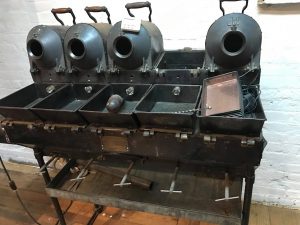
This is a sampler testing machine where they test the coffee beans. in this machine they test the beans for its quality.theres some rules to sample the coffee bean it should be stored in a cool and drak place.The sample they roast 24 hours of cupping the beans.
 This is sampler coffee stored for testing.
This is sampler coffee stored for testing.
This is a Coffee roasting machine.This is where they roast coffee beans.so there are two species of coffee Robusta and Arabica. Robusta coffee has more caffeine, it has a strong and bitter taste. and one the other side Arabica has much less caffeine than Robusta.has a sweeter taste.
Brooklyn Coffee Roastery is 85% fair trade.All of their coffee beans are locally roasted every day.They have coffee beans from all around the world.Brazil, Mexico.Kenya, Costa Rico etc.They also have organic and sustainable coffees.
It was an amazing experience and I really learned a lot.
During this semester in Wine and Beverage Management, my knowledge of wine and spirits world has been enhanced.Through the study of viticulture, vinification and production spirits production I now have knowledge to the point of I go into a wine shop I know what I’m looking for and what questions to ask.
For the winery visit project I decided to go to Bedell Cellars on the North Fork of Long Island. This visit was set up by the wine director at my job, he put me in contact with the Regional Sales Director, Whitney Beaman, and was able to set up a reservation for November 25th at 12pm to visit. Whitney made sure we received a VIP complimentary tasting flight as well as a tour of the vineyard and Cellars.
It was a long ride on the LIRR but the scenery of Long Island and traveling over the Long Island sound was so peaceful and gave me a chance to just relax and unwind after the busy Thanksgiving weekend at work.
Long Island Sound
Once we arrived over the sound!
When we arrived at Bedell, we were greeted by Brad who attended to use throughout our visit. We were able to chose our seats and when we sat, Brad offered us the tasting flight menu which showcased a cider, white wine and three red wines.
I love cider so I was pretty happy we start off with that. Brad explained to us that the the cottage cider is served to help cleanse the palate between courses as well as to awaken the palate.
Wine list
He then explained that the cottage cider is made by apples grown in the cottage at Bedell’s historic farmhouse on site which was built in 1710. The cottage cider was very crisp and fragrant with a hint of tartness, perfect way to introduce a flight menu.
Bedell cultivates there own yeast instead of purchasing commercial yeast.
The next on the menu was the 2016 First Crush White which is a blend of 40% Chardonnay, 30% Gewurztraminer, 20% Sauvignon Blanc, and 10% Riesling. This wine was one of my favorites with a nose of tart apples, a taste of apple and citrus and a light fresh balanced finish. This wine was pretty calm and would be something a beginner would appreciate.
Brad suggested that we take a brief break before the red wines to take a tour. We first went outside where the have beautiful white picnic tables overlooking the rows of vines, offered for seating when the weather permits.
White picnic tables
More outdoor seating
Even though the vines are in dormancy, seeing the rows upon rows of vines was mesmerizing.
Found some Cabernet Franc grapes left on the vine.
Brad informed us that Bedell is arguably the third oldest vineyard in the North Fork.
Miles of grape vines
On the wall was a vine with the roots intact, I asked what it was and Brad told me that’s one of the oldest Chardonnay vines the have planted in 1980.
Destemer for white wines
They put it up for display and every now and again they will plant it, considering the vine is over 30 years old the vintage made from those vines will be more full bodied and robust compared to the younger vines.
Stainless steel fermentation tanks
We then went to into the cellar and bottling room and it was nice to see all of the French oak barrels and steel tanks.
French oak barrels- All red wines see the oak and whites are destemed and fermented in steel tanks
The French oak barrels as well as the steel tanks are labeled with the grape variety, date and time, and a thermostat that keeps the wine at a constant temperature.
Stainless steel tanks that hold between 1300 and 2500 lbs of delicious wine
Large oak tank
In the cellar there was a glass case with different types of soil and gravel that displays the soil type of the North Fork.
North Fork terrior
We were informed that the soil there is rocky and sandy and fertile due to the glaciers that created the North Fork. The climate is maritime due to its glacial soils, Long Island sound and Atlantic Ocean to the east.
Labels!
Malbec labels
We then went to tour the bottling room which is small but efficient bottling and labeling twenty bottles per minute.
Presidential inauguration ceremony dinner menu for Barack Obama’s second term.
Brad told us that Bedell’s 2009 Merlot was the first ever New York wine to be served at Presidential inauguration ceremony for Barack Obama’s second term.
Once we returned, we were poured the third wine, the first red wine of the day named Taste Nouveau 2017 created using the classic carbonic maceration technique by fermenting whole grape clusters, 90% Merlot and 10% Malbec. I’m not to fond of red wines but surprisingly the second red wine on the flight menu was my favorite, it was a 2015 Cabernet Franc.
The nose on this wine was shocking it had the aroma of farm fresh room temperature butter. This wine is fermented in the oldest oak barrels available on site, which gives the wine immense vanilla taste and the nose of buttery baked goods. To finish of the flight menu was Taste Red 2013, a full-bodied blend of 50% Merlot, 30% Syrah, 14% Petit Verdot, 4% Malbec and 2% Cabernet Franc. I liked the last wine but the ripe tannins were a little much for my taste.
While we had our tasting I ordered some farm fresh goat cheese and crackers and honey to accompany our tasting. Having that as a palate cleanser made it easier to enjoy the red wines.
Small bites
Overall, visiting Bedell was the perfect thing to do on a Saturday. A chance to have a day off from the hustle and bustle of the city. This marks the beginning of my interest of visiting wineries, it was so intriguing to have a view of how wine is produced. I’ll be sure to visit Bedell and other vineyards in the North Fork when it’s warmer and the grapes are flourishing.